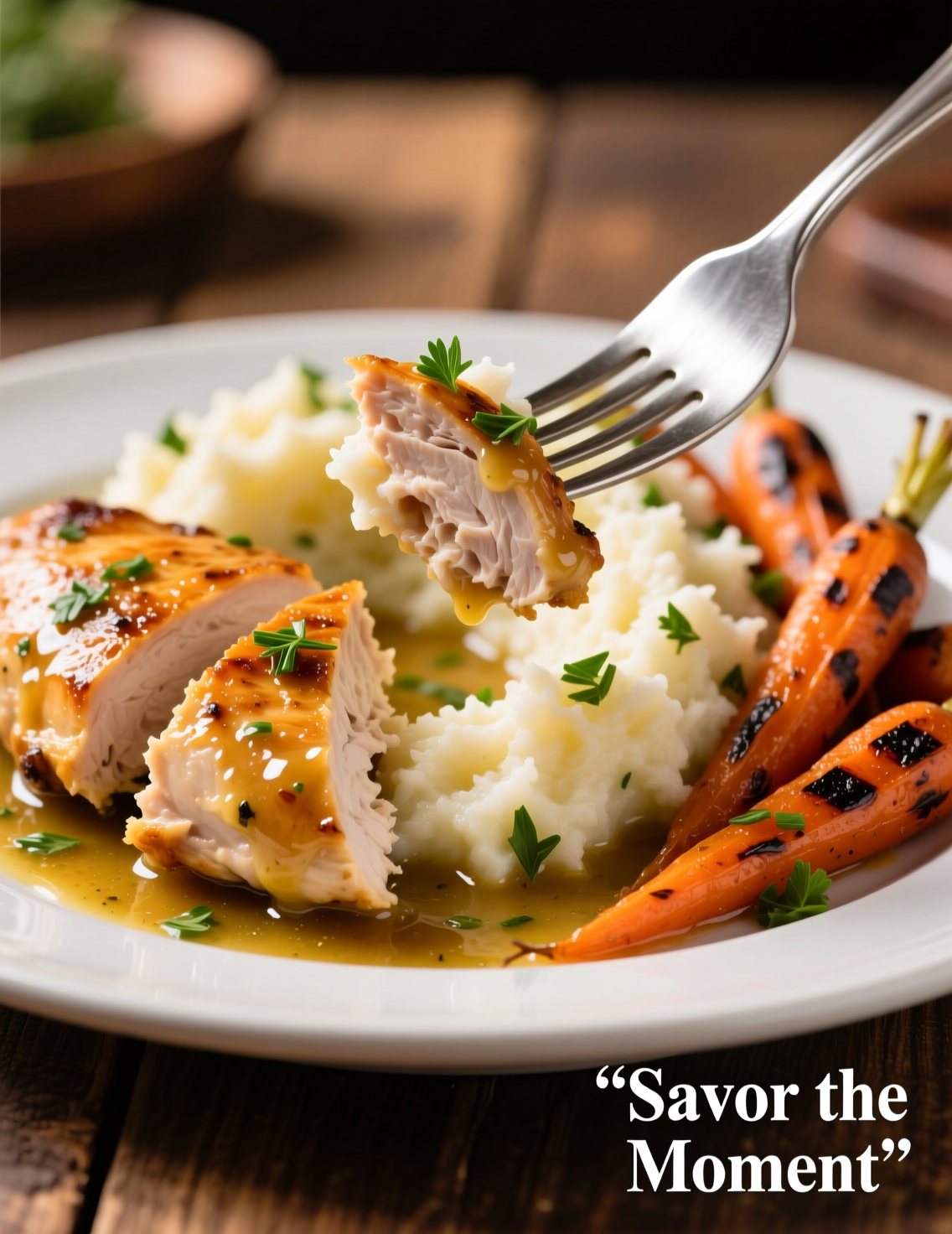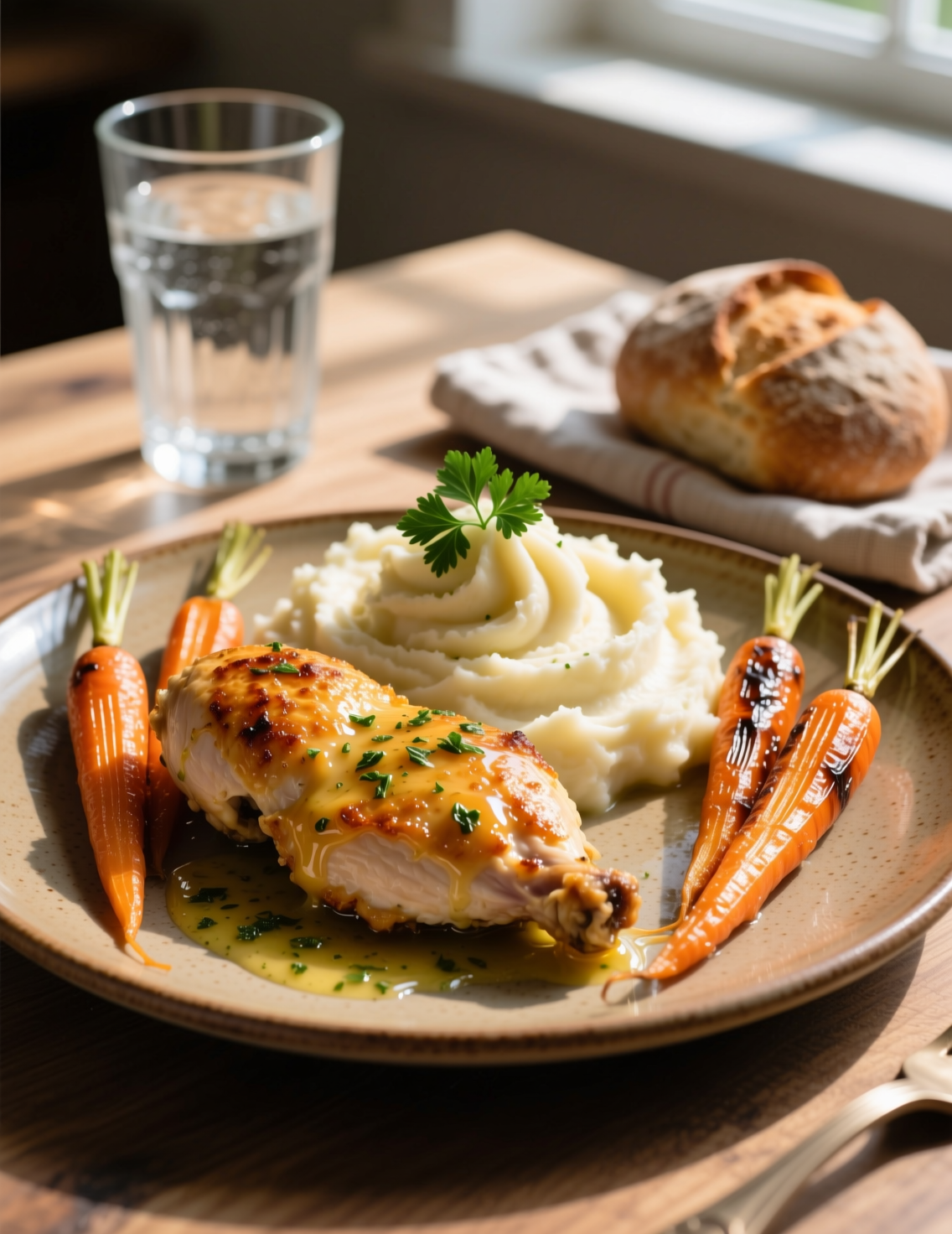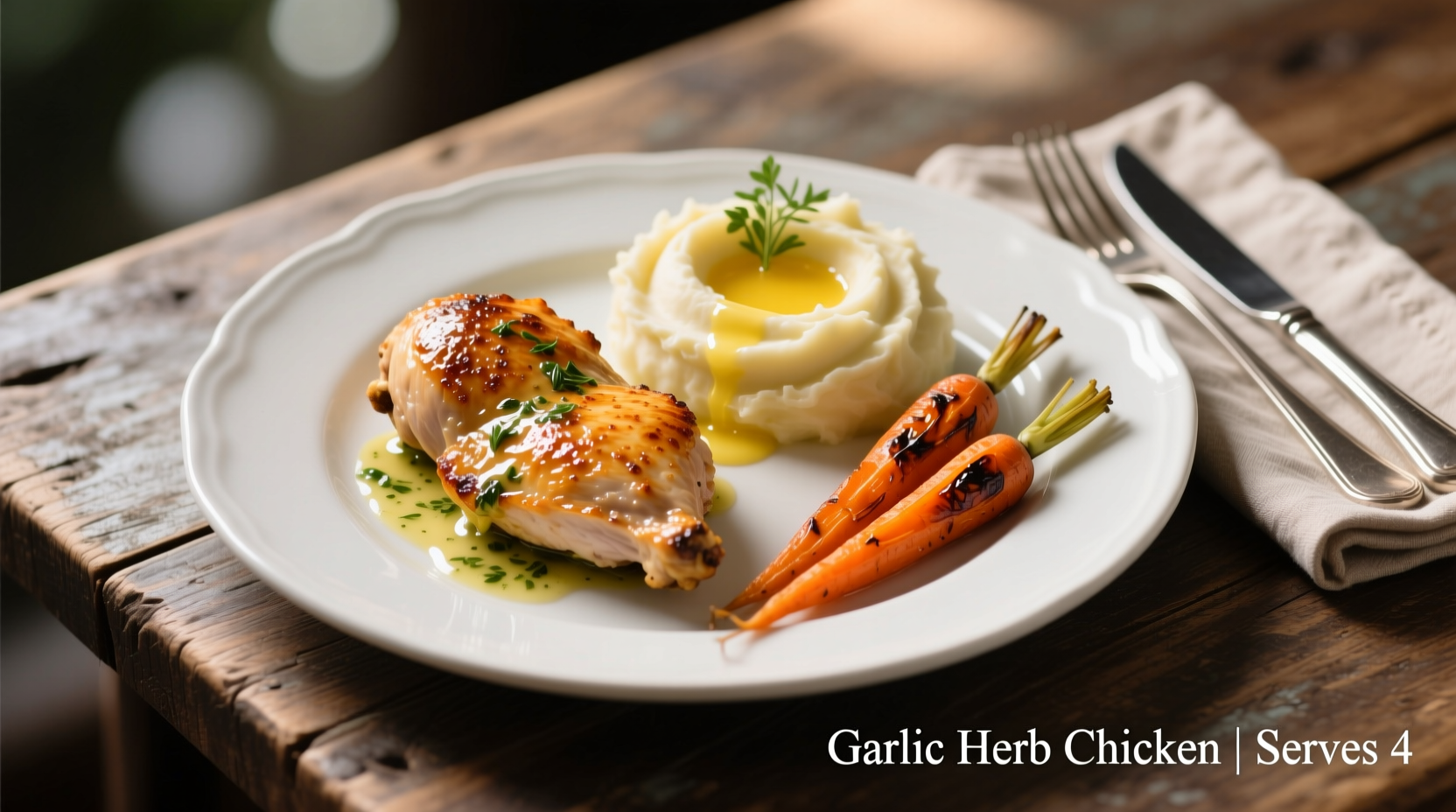The truth is, simple plates done right will always beat fussy ones. Garlic herb chicken paired with creamy mashed potatoes and roasted carrots is one of those plates. It’s hearty, balanced, and if you’re a professional chef or serious home cook, the layering of flavors here gives you enough wiggle room to show off skill while still keeping things approachable.
Why This Dish Works
The balance here is undeniable. You’ve got savory protein with a punchy garlic herb crust, a rich starch mellowed with cream, and sweet carrots roasted until caramelized. Contrast is the key. Too many dishes aim for richness everywhere and collapse. This one respects harmony.
And here’s the thing: roasted carrots aren’t just filler. According to a USDA nutrient database, carrots hold 41 calories per 100g but deliver beta carotene and fiber that play well with high-fat elements like cream. That’s culinary nutrition in action, not just numbers on paper.
Ingredients Breakdown
For four servings, precision matters. It’s not just about scaling up—professional kitchens lose thousands every year from careless portioning.
- 4 medium chicken breasts (about 6 oz each)
- 4 tbsp butter, softened
- 3 cloves garlic, finely minced
- 2 tsp fresh thyme leaves
- 2 tsp fresh rosemary, chopped
- 2 tbsp fresh parsley, chopped
- 1 tbsp olive oil
- 1 lb carrots, peeled and cut into batons
- 2 lb Yukon gold potatoes, peeled and cut into chunks
- ½ cup heavy cream
- ¼ cup milk
- Salt & black pepper to taste
Even if you know the ratios by heart, write them down. It saves mental bandwidth in service when ten things are happening at once.
Garlic Herb Chicken: Technique Matters
Chicken breast gets a bad rap for being dry. That happens when cooks rely on temperature guesses. In truth, the target is 165°F internal, but pull it at 160°F and let carryover heat finish. A 2011 USDA guideline clarified that holding poultry at lower temps for specific times is safe—so 155°F for 54 seconds achieves the same safety. Professionals use this data to keep texture perfect.
The butter mixture is your power move. Butter carries fat-soluble flavors from garlic and herbs straight into the meat. Spread it under the skin if available, or coat thoroughly on the surface. Pan searing in olive oil for 3 minutes per side gives color. Then finish in a 375°F oven for 10–12 minutes.

Creamy Mash: Science of Comfort
Yukon gold potatoes strike the balance between starchy and waxy. Russets whip up fluffier, but they fall apart with cream. Waxy potatoes resist mash. Yukons give you silky mash with just enough structure to hold.
Boil the potatoes in salted water until tender. Never skip salting the water—osmosis seasons from the inside. Once drained, run them through a ricer. Do not use a blender unless you enjoy gluey paste. Add butter first, then warm cream and milk. This order matters. Butter coats starch granules, reducing water absorption, which keeps texture smooth.
Cream content can be adjusted. French kitchens often use a 1:2 ratio cream to potato by weight, but for balance with the chicken, keep it lighter.
Roasted Carrots: Simplicity Elevated
Carrots transform in the oven. At 400°F, natural sugars caramelize around 320°F. That’s where flavor shifts from earthy to candy-sweet. Cut them evenly so they cook at the same pace. Toss with olive oil, salt, and pepper.
A sprinkle of thyme before roasting ties back to the herbs in the chicken. Professionals know this is how you build menu cohesion without overwhelming the guest. Every plate should feel like one conversation, not three arguments.
Professional Timing and Workflow
If you’re running a line, timing is survival. Here’s a flow:
- Preheat oven. Start carrots—they take longest.
- While carrots roast, start potatoes boiling.
- While potatoes boil, prep chicken with herb butter.
- Sear chicken while carrots finish, then slide pan into oven.
- Drain and mash potatoes as chicken rests.
This workflow ensures no dead time. Total cooking: 40–45 minutes with overlap.
Plating for Impact
Presentation is not garnish for garnish’s sake. It’s communication. The creamy mash should act as a base. Place a quenelle or spoonful at the center, rest chicken sliced on the diagonal on top, carrots off to the side with a slight angle.
Contrast color: sprinkle parsley or microgreens for freshness. White plate works best. Food styling studies show that neutral plates increase perceived food quality by 13%. Not a gimmick—psychological data supports it.
Variations for Professionals
Menus crave flexibility. Swap herbs—tarragon instead of rosemary for a softer anise note. Replace carrots with parsnips in winter for a nuttier sweetness. Add lemon zest to the butter for brightness in spring menus.
Restaurants often serve this with pan jus. Deglaze the chicken pan with white wine, reduce, mount with butter. Adds depth, costs little, impresses a guest.
Common Mistakes and Fixes
Dry chicken is the usual villain. Solution: temperature control and resting. Letting meat rest 5 minutes redistributes juices, proven by meat science studies.
Runny mash happens when potatoes are overworked or cream added cold. Solution: warm dairy gently before mixing.
Carrots burning? Likely overcrowding the pan. Use a wide sheet tray, give them space for air circulation.

Nutrition Perspective
Per serving, expect around 520–600 calories depending on butter and cream ratios. That includes 36g protein, 48g carbs, and 22g fat. This makes it balanced for an evening meal. The carrots boost fiber and antioxidants like beta carotene, which the body converts to vitamin A.
Cultural Angle
Dishes like this live in the middle ground between rustic comfort and refined dining. Think of French poulet rôti, mashed potatoes like Robuchon’s legendary purée (50% butter to potato), and roasted root vegetables from farmhouse cooking. It’s a global hybrid of techniques and traditions.
Trends in 2025
More kitchens are turning to “elevated comfort.” Diners want familiarity with finesse. Garlic herb chicken with creamy mash fits perfectly. Google Trends shows searches for “herb roasted chicken” rising 18% year-over-year. The market isn’t bored of chicken—they want better chicken.
Chefs are also leaning on hyper-local produce. Using heirloom carrots or specialty potatoes allows for narrative in the menu. A plate becomes a story, and guests buy stories as much as flavors.
Expert Tips for Scaling Up
Cooking for 4 is one thing. Cooking for 40, another. Batch cooking potatoes means holding them warm without drying. Use a covered bain-marie over gentle steam. For chicken, sous vide at 150°F for one hour before finishing with a pan sear ensures consistency at scale. Carrots can be roasted ahead, then flashed in a hot oven before service.
Final Thoughts
Garlic herb chicken with creamy mash and roasted carrots is more than a recipe. It’s a study in balance, timing, and detail. Each component alone is good. Together, they become complete.
If you’re cooking at home, focus on patience and sequence. If you’re in a professional kitchen, think efficiency and cohesion. Either way, it’s a plate that delivers comfort without apology.
So, next time someone shrugs at chicken breast, put this dish in front of them. Let the garlic, the cream, the caramelized carrot do the talking. They’ll get it.
FAQs
How do I keep garlic herb chicken from drying out?
Pull the chicken at 160°F and let carryover heat finish cooking to 165°F.
Why use Yukon gold potatoes for mash instead of russets?
Yukon golds give a creamy yet structured mash without turning gluey.
Can I roast carrots at a lower temperature?
Yes, but 400°F caramelizes sugars faster and gives better flavor.
Do I need fresh herbs, or can I use dried ones?
Fresh herbs are best, but dried can work if used in smaller amounts.
How far in advance can I prep mashed potatoes?
You can make them a few hours ahead and hold warm over gentle steam.
What wine pairs best with this dish?
A crisp Chardonnay or Sauvignon Blanc cuts through the richness.
Is there a lighter option for the creamy mash?
Swap cream for low-fat milk or even Greek yogurt for a lighter texture.
How can I scale this recipe for a crowd?
Sous vide the chicken and batch roast the carrots, then finish before service.
Why rest the chicken after cooking?
Resting redistributes juices, keeping the meat moist and flavorful.
Can I swap carrots for another vegetable?
Yes, parsnips or roasted squash make excellent seasonal alternatives.

Mariana is a passionate home cook who creates delicious, easy-to-follow recipes for busy people. From energizing breakfasts to satisfying dinners and indulgent desserts, her dishes are designed to fuel both your body and hustle.
When she’s not in the kitchen, she’s exploring new flavors and dreaming up her next recipe to share with the Foodie Hustle community.

